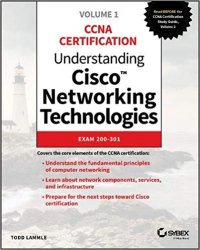 Название: Understanding Cisco Networking Technologies: Volume 1 Exam 200-301
Название: Understanding Cisco Networking Technologies: Volume 1 Exam 200-301Автор: Todd Lammle
Издательство: Sybex
Год: 2020
Формат: True PDF
Страниц: 400
Размер: 13.3 Mb
Язык: English
Covers the core elements of the CCNA certification:
Understand the fundamental principles of computer networking
Learn about network components, services, and infrastructure
Prepare for the next steps toward Cisco certification
Read BEFORE the CCNA Certification Study Guide, Volume 2 ― Covers core CiscoTM network technologies
Understanding Cisco Networking Technologies, Volume 1, is your first step on the path to preparing for Cisco's EXAM 200-301: Implementing and Administering Cisco Networking Technologies certification and the world of Internetworking. Cisco certification is a perfect way to enter the IT sector or advance your current IT career. Cisco Certified Network Associate (CCNA) is the associate-level certification that validates your ability to implement and administer a wide range of IT networking technologies. This book covers everything you need to know for preparing for both your CCNA studies and the future of your career.
You will gain a solid foundational knowledge of networking and develop real-world network management skills. Clear, easy-to-follow chapters cover topics such as the basics of the Open Systems Interconnection (OSI) model, ethernet networking, TCP/IP, the Cisco Internetworking Operating System (IOS) and command-line interface (CLI), router configuration and management, and much more. Throughout the text, practice examples reinforce key information and what you need to know for the CCNA exam.
In-depth yet highly readable, Understanding Cisco Networking Technologies is a must-have for anyone thinking of entering the IT profession, preparing for the CCNA certification, or wanting to develop a strong understanding of core Cisco networking technologies.
Learn аbout:
Open systems interconnection
Ethernet networking and data encapsulation
Internet Protocol and IP addressing
Subnetting a network
Troubleshooting IP issues
Managing a Cisco internetwork
Configuring network devices
IP addressing and static, default and dynamic routing
Wide Area Network (WAN) protocols